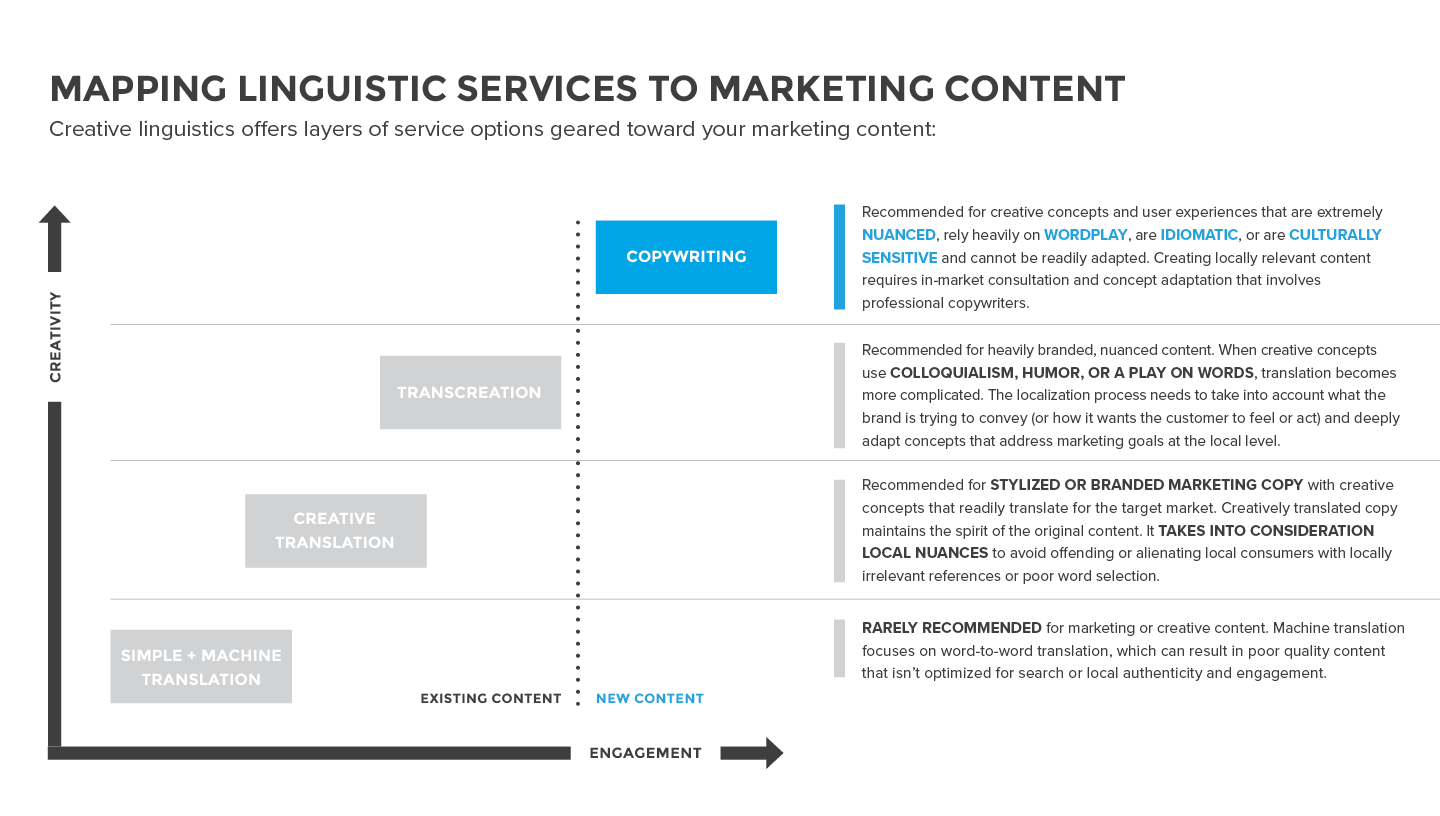2023 was another wild year for international marketers. With increased workloads, less budget, and fewer resources, 2024 is shaping up to be a challenging year – but with some very bright opportunities. Here are your top global marketing trends for 2024.
2024 GLOBAL ECONOMIC OUTLOOK
The worldwide economic slowdown will continue in 2024, Euromonitor reports. Global consumers will have less savings, making the competition for their limited disposable income all the more intense. And global marketers’ jobs will be even more challenging.
But it’s not all doom and gloom. India is expected to be the fastest-growing major economy in 2024, with a forecasted GDP growth of 6.1%. (Compare that to .8% in the US and .6% in the UK.) It’s a huge opportunity, and one ripe for hyperlocalization. (Read on for more on hyperlocalization.) Vietnam, the Philippines, and Indonesia are also expected to grow more than 5% this year.
So, depending on their industries, global marketers may have the chance to ramp up growth in these regions as performance slows in other locales.
TIGHT BUDGETS, TOUGH CHOICES
When business conditions get tough, marketing and localization are often the first to feel the heat. The current economic slowdown is no different. Localization and international budgets get slashed.
And facing pressure for immediate revenue, global marketing departments shift focus away from slow-burn brand-building activities and toward quick-win, conversion-based tactics.
The problem is, businesses can’t cut their way to growth. Pulling back on localization activities has long-term, negative impacts on global growth that greatly exceed the short-term cost benefits.
And in markets where brands are less established, sacrificing awareness efforts means that when international consumers get ready to make their buying decisions, they’re less likely to purchase from those companies that haven’t taken the time to build a strong relationship with them. These losses are compounded when consumers have less disposable income and are less likely to take risks on unknown brands.
Of course, whatever the longer term impact of cuts might be, global marketers need to address the reality of what’s happening now – not just in the future.
So, to continue growth despite challenging circumstances, marketers will need to get scrappy. And they’ll need to be intentional about where they spend their efforts.
INTEGRATING AI & MACHINE TRANSLATION WITHOUT SACRIFICING IMPACT
AI is everywhere. As with domestic marketing, global marketers can use AI to accelerate efficiency, productivity, and effectiveness.
From busting through writer’s block to versioning of ads to multivariate testing, there is no end to the creative ways global marketers can harness AI to work better. But as with any tool, AI is only as effective as the people leveraging it. AI can unleash incredible human talent – or it can churn out junk at hyperspeed. Generative AI users who focus on massive volume over quality can ramp up the noise for everyone and make it harder for your global audiences to find your content. Developing a strong global brand – and leveraging AI to empower your human experts – will help you stand out from the crowd.
Building trust is key. The noisier your landscape gets, the more valuable it is to position your brand as a reliable source – of insight, of engaging content, of quality. Ensuring your brand positioning and tone of voice comes through – no matter the language or medium – is crucial. And your efforts will pay off when your cost-conscious global consumers are ready to buy.
We’re also seeing more companies explore machine translation in an effort to cut costs. Here, it’s important to remember that in global marketing, translation is a tactic – not the goal. And it’s critical to align the right level of language adaptation to the nature and purpose of your content. It’s all about the right tool for the right job. Have some high-volume, low-visibility content? Machine translation (with a professional translator editing) may be sufficient. But a campaign headline or something highly creative? It’s best to stick with human talent. Want your audience to take action – engage, sign up, buy? There, too, you’ll need humans to drive that connection.

With an intentional approach to language, international marketers can use their resources more effectively. By using machine translation in the right places, marketers can free up budget to spend more on creativity where it really counts, maximizing ROI and impact.
If you’re struggling to determine how AI can improve your global marketing or when and where to use machine translation vs human localization, the right partner can help.
FOCUS ON EFFICIENCY
AI is helping international marketing teams automate tasks and increase productivity. And with restricted budgets, global organizations are also looking to optimize their processes to deliver on aggressive global growth goals and reduce operational overhead.
STREAMLINING GLOBAL MARKETING PROCESSES
When times are tight, previously ignored inefficiencies can come to the forefront. More companies are focusing on improving how they track global marketing projects, from planning to implementation to execution. ROI reporting becomes paramount as budgets tighten and marketers are under more pressure to prove their team’s value.
International marketers are also facing a prolonged, involved approval process for purchase orders. They’re responding by shifting toward advance billing to make sure these cumbersome processes don’t impact their ability to deliver on their global objectives.
REMOVING CROSS-COUNTRY SILOES
Scalability is crucial for many industries, and perhaps none so much as streaming services. In 2024, these companies are looking to build internal global cohesion to drive efficiency. This means getting buy-in from previously siloed regional and in-market teams.
It’s a struggle to move toward a more centralized approach to global marketing and localization. And there’s risk of reducing the effectiveness of the brand’s in-country efforts through overcentralization. By adapting a hybrid model – which balances the efficiency of centralization with the effectiveness of a decentralized model – these brands (and really, any global organization focused on scale) will see stronger global growth, brand alignment, and productivity.
REPURPOSING CONTENT ACROSS MULTIPLE CHANNELS
Creating multi-purpose content is nothing new – it’s an understood best practice. But with the hyperfocus on driving value while reducing costs, it’s top of mind for global marketers. Brands have to find ways to make their global content go further.
Considering how content can be repurposed from the outset of a project is key. A blog post can transform into great content on social, or an eye-catching visual. Longer YouTube videos can be adapted for shorter-form platforms.
Translation memories are a common tool international companies use to save costs (parsing previously localized content so it can be reused in the future.) Though generally used for more broadscale, straightforward content, skilled localization experts can help you use this tool for more creative, marketing-focused content. And thereby save you money and ensure your brand voice shines through in every piece of copy, in all your target markets.
NARROWING IN WITH HYPERLOCALIZATION
Global brands big and small are digging into the data to understand how localization powers their growth – and where they need to take their targeting to the next level to drive success.
So we’re seeing a larger investment in highly targeted content on a per-market basis. Rather than mass-translating content, these brands look for copywriting services to create from-scratch content in each market, in line with their global strategy. The goal is to really speak to customers in target locales with content that’s made specifically for them.
Though this is a more expensive approach, it can pay dividends. In the age of authenticity and social media, brands are increasingly finding that it’s worth the investment. Whether you want to target a specific region or city – or even just provide a highly localized experience at a market level – this higher ROI-tactic can complement a more budget-conscious approach to in-language content.
OUTSIZED ROI WITH NICHE CHANNELS, SOCIAL COMMERCE, & STREAMING
Hyperlocalization opens the door for global marketers to build an engaging presence on niche or market-specific platforms. These highly targeted efforts help brands reach audience members that may not engage with their normal channels – and in places where their competition doesn’t even know to look. From Xing in Germany to Remember in Korea and Japan, these smaller platforms may allow you to reach the right contacts more cost-effectively than platforms like Meta or LinkedIn.
And in some cases, local regulations have made it untenable for large global platforms to operate. In December 2023, Twitch announced it would cease operations in South Korea after high network fees made it “prohibitively expensive” to continue in the country. Local person-to-person (P2P) platform AfreecaTV is likely to absorb Twitch’s local users – and perhaps its advertisers as well.
The growth of social commerce is expected to continue, with platforms continually rolling out new eCommerce integrations. And with the growing importance of global for the platforms themselves, international rollouts for these new commerce features are happening faster as well. (In October, Pinterest announced several new, globally available integrated commerce features, including a dynamic AI-powered product ad generator, quizzes, and user collages.)
Despite economic uncertainty, global advertising is expected to grow in 2024. With more international streaming services releasing ad-supported plan tiers (free or paid), global marketers will have an additional opportunity to reach their global audiences. And in a more controlled environment than YouTube or other social media channels.
FINAL THOUGHT
2024 will be another challenging year for global marketers. By focusing on efficiency, productivity, and (most importantly) your audience, you’ll be able to save budget on lower-impact activities while crafting bespoke in-market experiences that move the needle on your 2024 growth goals.
Need to know how to spend your global budget more effectively? Want to smooth out hiccups in your global marketing workflows? We’re here to help. Get in touch now.


